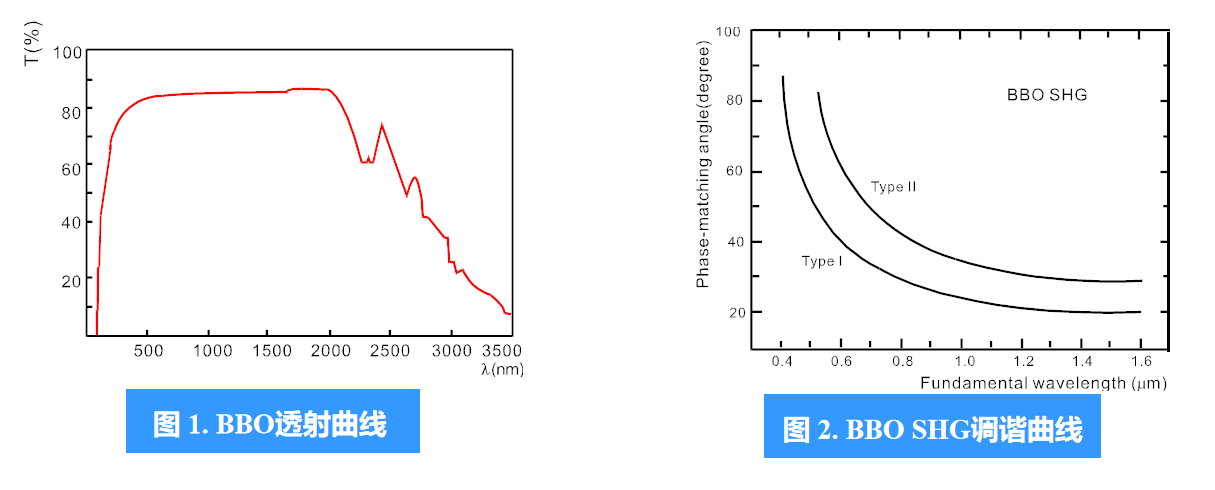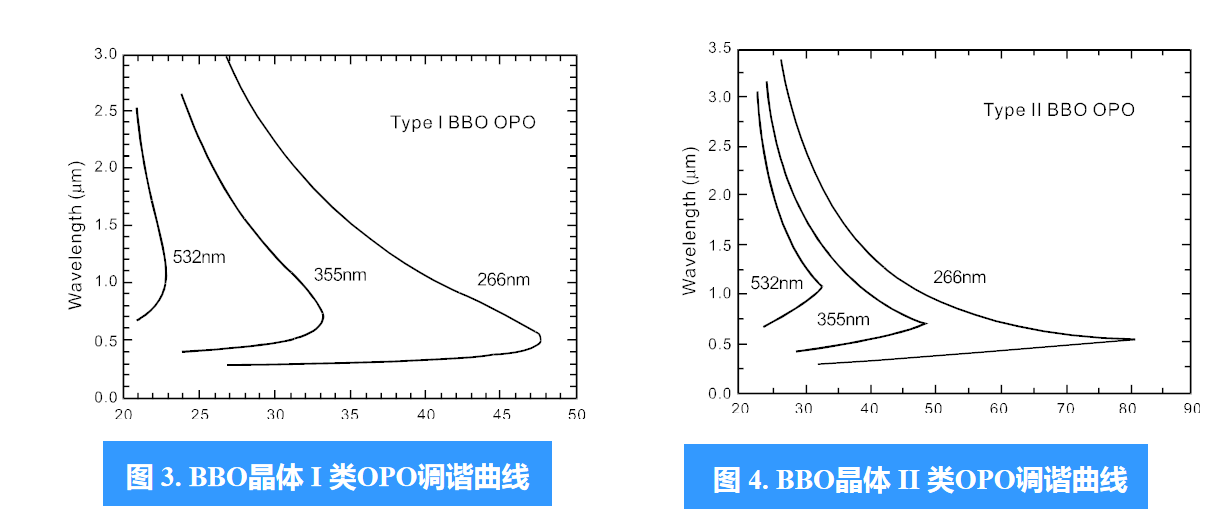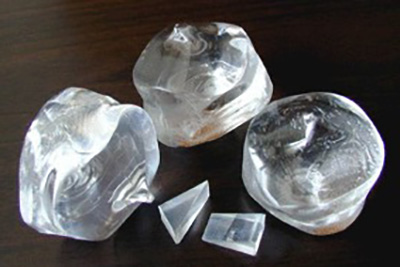Product description
Main Advantages
- Wide phase matching band (409.6 - 3500 nm)
- Broad transmission band range (190 - 3500 nm)
- High second harmonic generation (SHG) conversion efficiency (equivalent to 6 times that of KDP crystal)
- High damage threshold
- Good optical uniformity δn≈10-6 /cm
- Wide temperature acceptance angle (~55 ℃)
- Used in the second, third, fourth and fifth harmonic generation of Nd:YAG lasers
- Widely applied in the harmonic generation of ultrafast lasers
What We Can Provide
- Strict quality control
- The thinnest crystal can be 0.005 mm, the longest can reach 25 mm, and the maximum size is 15×15×15 mm3
- Anti-reflection (AR-coating) or protective (P-coating) film deposition, holder assembly and re-polishing and coating services
- Ample inventory
- Fast delivery (The delivery time for polished wafers is 15 working days, and the delivery time for coated products is 20 working days)
Basic Characteristics
|
Crystal Structure
|
Trigonal system, space group R3c
|
|
Unit Cell Parameters
|
a=b=12.532 Å, c=12.717 Å, Z=6
|
|
Melting Point
|
Approximately 1095 ℃
|
|
Mohs Hardness
|
4 Mohs
|
|
Density
|
3.85 g/cm3
|
|
Thermal Conductivity
|
1.2 W/m/K (⊥c); 1.6 W/m/K (∥c)
|
|
Coefficient of Thermal Expansion
|
α11=4×10-6 /K, α33= 36×10-6 /K
|
|
Transmission Band
|
190 - 3500 nm
|
|
SHG Phase Matching Range
|
409.6 - 3500 nm (TypeⅠ) 525 - 3500 nm (TypeⅡ)
|
|
Thermo-Optic Coefficient
|
dno/dT=-16.6×10-6 /℃
dne/dT=-9.3×10-6 /℃
|
|
Absorption Coefficient
|
<0.1%/cm @ 1064 nm, <1%/cm @ 532 nm
|
|
Acceptance Angle
|
0.8 mrad·cm (θ, TypeⅠ, 1064 SHG)
1.27 mrad·cm (θ, TypeⅡ, 1064 SHG)
|
|
Temperature Bandwidth
|
55 ℃·cm
|
|
Acceptance Spectral Width
|
1.1 nm·cm
|
|
Walk-off Angle
|
2.7° (TypeⅠ, 1064 SHG)
3.2° (TypeⅡ, 1064 SHG)
|
|
Nonlinear Optical Coefficient
|
deff(Ⅰ)=d31sinθ+(d11cos3Ф-d22sin3Ф)cosθ
deff(Ⅱ)=(d11sin3Ф+d22cos3Ф)cos2θ
|
|
Non-zero Nonlinear Optical
Coefficient
|
d11=5.8×d36(KDP)=2.55 pm/V
d31=0.05×d11
d22<0.05×d11
|
|
Sellmeier Equation
(λ unit μm)
|
no2 = 2.7359 + 0.01878 / (λ2 - 0.01822) - 0.01354 λ2
ne2 = 2.3753 + 0.01224 / (λ2 - 0.01667) - 0.01516 λ2
|
|
Electro-Optic Coefficient
|
γ22=2.7 pm/V
|
|
Half-Wave Voltage
|
7 KV(@ 1064 nm,3×3×20 mm3)
|
|
Resistivity
|
>1011 ohm•cm
|
|
Relative Dielectric Constant
|
ɛs11/ɛo: 6.7
ɛs33/ɛo: 8.1
Tanδ<0.001
|
BBO is a negative uniaxial crystal, and its refractive index of the ordinary ray (no) is larger than that of the extraordinary ray (ne); Type I and Type II phase matching can be obtained through angle tuning, and its SHG phase matching is shown in Figure 2.

Applications in Nd:YAG Lasers
The BBO crystal has excellent performance in the second, third and fourth harmonic generation of Nd:YAG lasers, and it is still one of the best choices for the fifth harmonic generation to output 213nm light. The conversion efficiency of the second harmonic generation is greater than 70%, the third harmonic generation is 60%, the fourth harmonic generation is 50%, and the power of the fifth harmonic generation output at 213 nm can reach 200 mW.
The BBO crystal is also an ideal intracavity frequency doubling crystal for high-power Nd:YAG lasers. Using the anti-reflection coated BBO crystal produced by us, an average power of more than 15 W of 532 nm light can be obtained through intracavity frequency doubling in an acousto-optic Q-switched Nd:YAG laser. Using the 600 mW light output from the frequency doubling of a mode-locked Nd:YLF laser as the pump source, 66 mW of 263 nm light can be obtained through extracavity frequency doubling of a BBO crystal cut at the Brewster angle on the end face.
Since the BBO crystal has a small acceptance angle and a large walk-off angle, the key to achieving an ideal conversion efficiency is to use a fundamental frequency light of good quality (with a small divergence angle, good mode conditions, etc.). We do not recommend focusing the fundamental frequency light beam.
Applications in Nd:YAG Lasers
1. Dye Lasers
Using a Type I BBO crystal can efficiently output second harmonic light with an efficiency of >10% and an ultraviolet light with a wavelength ≥206nm (205 - 310 nm). When doubling the frequency of a dye laser pumped by an XeCl laser with a peak power of 150 KW, a conversion rate of 36% can be obtained (about 4-6 times higher than that of ADP). The conversion rate of the shortest 204.97 nm light obtained from the second harmonic generation is about 1%.
The BBO crystals produced by Zhongce are widely used in dye lasers. Using BBO to perform type I sum frequency mixing of 780 - 950 nm light and 248.5 nm light (the SHG output of a 495 nm dye laser), the shortest ultraviolet light of 188.9 - 197 nm can be obtained, with the laser pulse energies being 95 mJ @ 193 nm and 8 mJ @ 189 nm respectively.
2. Ultrashort Pulse Lasers
In the applications of second and third harmonic generation of ultrashort pulse lasers, the performance of the BBO crystal is superior to that of KDP and ADP crystals. For such applications, the minimum thickness of the BBO crystal that Zhongce can currently provide is 0.005 mm. When both the phase velocity and group velocity matching are satisfied simultaneously, an effective frequency doubling of a 10 fs laser pulse can be achieved with a thin BBO crystal.
3. Ti:sapphire Lasers and Alexandrite Lasers
Using a BBO crystal, the type I second harmonic of the alexandrite laser can output ultraviolet light with a wavelength range of 360 nm - 390 nm, among which the pulse energy of the laser at a wavelength of 378 nm is 105 mJ (with a second harmonic conversion rate of 31%), and the third harmonic can output ultraviolet light with a wavelength range of 244 - 259 nm and a pulse energy of 7.5 mJ (with a mixing conversion rate of 24%).
The second harmonic conversion efficiency of the Ti:sapphire laser can be higher than 50%, and its third and fourth harmonic conversion efficiencies are also relatively high.
4. Argon Ion Lasers and Copper Vapor Lasers
By using the intracavity frequency doubling technology in an argon ion laser with a full-line output power of 2 W, 36 deep ultraviolet lights with a wavelength range of 228.9 - 257.2 nm can be obtained from a BBO crystal cut at the Brewster angle on the end face, with the maximum power being 33 mW @ 250.4 nm.
The average output power of the second harmonic of the 510.6 nm copper vapor laser can reach 230 mW @ 255.3 nm, and the maximum energy conversion rate is 8.9%.
Applications in Optical Parametric Oscillators (OPO) and Optical Parametric Amplifiers (OPA)
The BBO crystal plays an important role in OPO and OPA, and can generate a series of tunable coherent lasers from ultraviolet to near-infrared. Figure 3 and Figure 4 show the calculation results of the tuning angles of Type I and Type II BBO crystals in OPO and OPA respectively.
1. OPO Pumped by 532 nm
Using a 532 nm pump light with an input energy of 40 mJ and a pulse width of 75 ps, an OPO output with a wavelength range of 680 - 2400 nm can be obtained from a 7.2 mm long Type I BBO crystal, with a peak power of 1.6 MW and an energy conversion rate of up to 30%. The longer the BBO crystal, the higher the energy conversion rate.
2. OPO and OPA Pumped by 355 nm
Using a 355 nm laser as the pump source, the tunable wavelength range of the OPO system using our BBO crystal is between 400 - 3100 nm, and the energy conversion rate in the wavelength range of 430 - 2000 nm is between 18% - 30%.
Type II BBO can be used to reduce the linewidth. A linewidth of 0.05 nm and an available conversion rate of 12% can be obtained using BBO. In Type II phase matching, a relatively long BBO crystal (>15 mm) is usually used to reduce the oscillation threshold.
Pumped by a 355 nm picosecond Nd:YAG laser, the pulses obtained from using a BBO crystal as an OPA have the characteristics of a narrow band (<0.3 nm), high energy (>200 μJ) and a wide tunability range (400 - 2000 nm). This OPA can achieve a maximum energy conversion rate of more than 50%, so it has superior performance in many aspects compared with ordinary dye lasers, such as high conversion rate, wide tunability range, easy maintenance, simple design, and convenient operation. The systems of BBO-OPO or BBO-OPA plus the second harmonic of BBO can achieve tuning in the range of 205 nm - 3500 nm.

3. Other Applications
Using a 308 nm XeCl excimer laser as the pump light for the OPO and tuning the angle of the Type I BBO crystal, the signal light with a wavelength range of 422 - 477 nm can be obtained. Using the 266 nm wavelength generated by the fourth harmonic of the Nd:YAG laser as the pump light, it has been reported that a complete wavelength output of the BBO-OPO from 330 nm to 1370 nm has been observed.
Pumped by a dye laser with a wavelength of 615 nm, an energy of 1 mJ and a pulse width of 80 fs, ultrashort pulses with a wavelength of 800 - 2000 nm, an energy greater than 50 μJ (up to 130 μJ) and a pulse width less than 200 fs can be obtained in the OPA of two BBO crystals.
Electro-Optic Applications of BBO Crystals
The BBO crystal can also be used in electro-optic applications, and it has a wide transmission range from ultraviolet to 3500 nm. In addition, the BBO crystal has a higher damage threshold compared with DKDP and LiNbO3 crystals. By using our electro-optic BBO crystal and the gain medium Nd:YVO4 crystal, an output power of more than 100 W and a repetition frequency of 1000 kHz can be obtained. At a repetition frequency of 5 kHz, the pulse width can be as short as 6.4 ns, achieving an energy of 5.7 mJ or a peak power of 900 kW. Compared with acousto-optic Q switches, the electro-optic applications of BBO crystals have many advantages, including short pulses, high beam quality, and compact structure. Although it has a relatively small electro-optic coefficient and a high half-wave voltage (for example, for a BBO crystal with a size of 3×3×20 mm3, the half-wave voltage is as high as 7 kV @ 1064 nm), the operating voltage of the BBO electro-optic device can be reduced by increasing the length of the BBO crystal and reducing the thickness in the electrode direction.
Currently, we can provide high optical quality Z-cut BBO crystals with a length of 25 mm and a thickness of 1 mm in the electrode direction, and can deposit anti-reflection films and gold/chromium plating on the sides according to requirements.
We Can Provide the Following Film Systems
- Select IBS or IAD coating technology according to customer application requirements
- Double-wavelength and triple-wavelength anti-reflection films with low reflectivity for the second, third and fourth harmonic generation of BBO crystals at 1064 nm
- Broadband anti-reflection (BBAR) films for BBO crystals used in second harmonic tuning lasers
- Broadband protective films for the OPO of BBO crystals
- High laser damage resistance threshold
- Long service life
- Customized film system services are available
Specifications of BBO Crystals
| Size Tolerance |
(W±0.1 mm)×(H±0.1 mm)×(L+0.5/-0.1 mm) (L≥2.5 mm)
(W±0.1 mm)×(H±0.1 mm)×(L+0.1/-0.1 mm) (L<2.5 mm)
|
| Effective Aperture |
90% of the central area |
| Internal Quality |
No visible scattering path or center detected by 50 mW green light |
| Surface Finish |
10/5, referring to MIL-PRF-13830B standard |
| Flatness |
≤λ/8 @ 633 nm |
| Transmission Wavefront Distortion |
≤λ/8 @ 633 nm |
| Parallelism |
20″ |
| Perpendicularity |
15′ |
| Angle Tolerance |
≦0.25° |
| Chamfer |
≦0.2 mm×45° |
| Edge Chipping |
≦0.1 mm |
| Damage Threshold |
>1.5 GW/cm2 @ 1064 nm, 10 ns, 10 Hz (Polished Wafer)
>1 GW/cm2 @ 1064 nm, 10 ns, 10 Hz (Anti-reflection Coating)
>0.3 GW/cm2 @ 532 nm, 10 ns, 10 Hz (Anti-reflection Coating)
|
| Quality Assurance Period |
One year (under normal use) |
Remarks:
- The BBO crystal is hygroscopic, so it is recommended that users use and store it in a dry environment.
- The BBO crystal has a low hardness, so please pay attention to protection during operation and do not damage the polished surface of the crystal.
- The BBO crystal has a small acceptance angle, so relatively meticulous operation is required when adjusting the angle.
- The BBO crystal can be customized according to customer requirements. Suitable crystal specifications will be recommended based on the main performance parameters of the provided laser, such as the pulse energy, pulse width, repetition frequency of the pulsed laser, the power of the continuous laser, as well as the beam diameter, mode conditions, divergence angle, and tunable wavelength range.
- For thin slice crystals, holder assembly can be provided free of charge.


